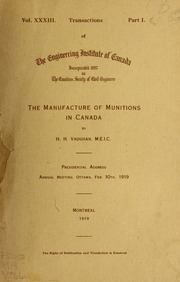I recently watched a youtube about the battle for Vimy Ridge in which huge numbers of Canadian soldiers were killed, along with hundreds of thousands of artillery rounds and probably millions of rounds of small arms ammunition being expended. In watching the youtube in Bertram's works, the sheer amount of time to machine one rough forging into a howitzer shell is quite long.
In watching the youtube about the battle for Vimy Ridge as well as this one, I find myself wondering how many other shops, aside from Bertram's, were turning out artillery shells. The amount of individual operations to machine one rough forging into a finished shell and the amount of hand-work, even to the preserving and crating kept quite a number of men busy. In watching the youtube, I was also struck by the tooling used. Bertram's, being a machine tool builder, likely had quite a toolroom to produce the specialized cutters and thread milling hobs- as well as the thread milling machinery. Bertram's probably had toolmakers going round the clock to keep up with tooling, re-grinding hobs and specialized cutters to sharpen them since HSS was about the only show in town back then. They probably also had an inspection department kept busy checking the various gauges for wear and re calibrating them against standards.
Of note also are the workmen. They are wearing overalls or shop coats and seem to have wool shirts or sweaters underneath. Since the film was taken in winter, maybe the works was not all that well heated- despite steam heating pipes along the walls shown in the film. The men's overalls appear shiny with oil and shop grunge (having had my own overalls get that way many times). Without modern washing machines, I am sure those men worked in clothing soaked in cutting oil and grunge week-in and week-out. In some of the old shops, as well as aboard the old ore carriers on the Great Lakes, dirty work clothes were sometimes washed in a barrel of water into which lye or boiler water treatment was added and steam then shot in. This got work clothes clean. Otherwise, the overalls and work clothes would likely have been hand washed by the men's wives or a local washerwoman on a washboard and gotten somewhat clean. All I could think of was how those men likely never got completely clean after a shift in that shop. I myself remember in the 1960's, working in a machine shop with soluble oil coolant in use. I got soaked in it from spray off the work during a shift. I'd clean up in the locker room and despite a quick shower, it seemed like I still reeked of that soluble oil. The old sulphur/lard based cutting oils really cling to a person and leave a distinct aroma. The men doing the final preserving of the shells, rolling them on the floor looked to be wearing overalls that were shiny from continued exposure to oil and shop grunge.
No one seemed to wear safety glasses, and the light in that shop did not look any too good. Still, no one was walking around with bandages or a patch on an eye.
The sequence at the start of the youtube gives some insight into the hardiness of the workforce. It is obviously winter. That was when winters were really winters and there was significant snowfalls and cold spells. The workforce comes out, some with coats unbuttoned, and no one climbs into a car to get home. The whole workforce seems to leave on foot. It is likely they walked home or rode streetcars (trams). No one had the luxury of sitting in a heated car to get home. No effort seemed to have been made to shovel a path thru the snow and the workforce had evidently tramped down the snow and walked out on it. Nowadays, if there is snowfall, businesses and homeowners get busy clearing the snow and throwing out tons of snow-melters like rocksalt or stuff sold as snow melters which won't stain the walkways and are "environmentally friendly". Schools close with the forecast of snow, let alone a real snowfall. Get a few inches of snow in many places nowadays and the whole area goes nuts. Action reporters ride around in huge SUV's claiming to be in "mobile weather labs" and act like a few inches of wet slush or snow is akin to crossing a polar ice cap. The workforce at Bertram's came out into the snow, walked over it without any problems maintaining their balance, and got on with their lives after what seemed a hard day in that shop.
A lot can be said about the workforce and Bertram's from that youtube. They all had a job to do, and they did it. Bertram's designed and built the tooling and re-tooled to make howitzer shells. The workforce may well have been men too old or otherwise unfit to be in the armed forces, and they put in a hard day's work and got the howitzer shells out the door. I have to wonder if any of those shells wound up being shot at the battle of Vimy Ridge, which was perhaps the greatest and toughest battle the Canadian forces fought in WWI.
Plainly, we have it quite soft in our present times, and this youtube shows just how far machine work as well as working and living conditions have come.


